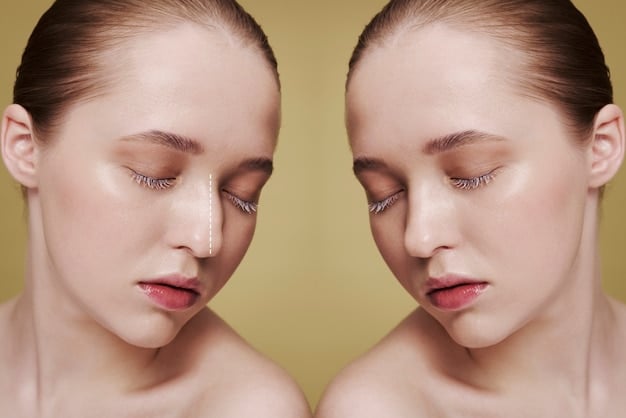Expert Tips: Choosing the Right Dermal Filler for Your Facial Structure in 2025

Choosing the right dermal filler in 2025 involves understanding your facial structure, the types of fillers available, and considering factors like longevity and potential side effects to achieve natural-looking results.
Navigating the world of dermal fillers can be overwhelming, especially with the advancements expected by 2025. This guide, Expert Tips: How to Choose the Right Dermal Filler for Your Specific Facial Structure in 2025, is designed to provide you with the knowledge you need to make informed decisions, ensuring you achieve the best possible results for your unique facial features.
Understanding Facial Structure and Aesthetics
Before diving into the specifics of dermal fillers, it’s crucial to understand your own facial structure and what aesthetic goals you’re hoping to achieve. Our facial anatomy plays a significant role in determining the appropriate type and placement of fillers.
Identifying Your Face Shape
Different face shapes respond differently to dermal fillers. Here’s a quick guide to help you identify your face shape:
- Square: Characterized by a strong jawline and a roughly equal width and length.
- Round: Features soft curves and similar width and length, lacking sharp angles.
- Oval: Longer than it is wide, with a gently rounded jawline and forehead.
- Heart: Wide forehead and cheekbones, tapering down to a pointed chin.
- Diamond: Wide cheekbones, with a narrower forehead and jawline.
- Rectangle: Similar to a square face but longer than it is wide.
Understanding your face shape is the first step in determining the best approach for dermal fillers. Knowing your natural contours and where volume is lacking will guide the choice of filler and injection technique.
Aesthetic Goals and Expectations
It’s essential to have realistic expectations about what dermal fillers can achieve. Common aesthetic goals include:
- Adding volume to cheeks and lips
- Smoothing fine lines and wrinkles
- Defining the jawline and chin
- Correcting asymmetry
Consulting with a qualified practitioner will help you clarify your goals and understand the potential outcomes. They can assess your facial anatomy and recommend the most suitable treatment plan.
Understanding your unique facial structure and aesthetic goals lays the groundwork for a successful dermal filler treatment. By having a clear understanding of what you want to achieve and how your face shape influences the outcome, you can approach the process with confidence and realistic expectations.
The Evolution of Dermal Fillers: What to Expect in 2025
The field of dermal fillers is constantly evolving, with new formulations and techniques emerging regularly. By 2025, we can expect even more advanced options that offer improved results and longer-lasting effects.
Next-Generation Filler Formulations
Future dermal fillers are likely to incorporate:
- Advanced cross-linking technologies: This will allow for longer-lasting results and improved structural integrity.
- Bioactive ingredients: Fillers may include substances that stimulate collagen production, enhancing the skin’s natural regenerative processes.
- Personalized formulations: Tailored fillers based on individual skin types and needs could become more common.
These advancements will not only extend the duration of the filler’s effects but also improve the overall quality and naturalness of the results.
Enhanced Injection Techniques
Advancements in injection techniques are also on the horizon:
- Microcannula techniques: These techniques reduce the risk of bruising and swelling, providing more comfortable and precise application.
- Ultrasound guidance: Using ultrasound to guide injections allows for greater accuracy and minimizes the risk of vascular complications.
These techniques will contribute to safer and more predictable outcomes, reducing the potential for adverse effects and enhancing patient satisfaction.

As we approach 2025, expect dermal fillers to become more sophisticated, offering enhanced results, greater safety, and personalized treatments. These advancements will empower individuals to achieve their aesthetic goals with greater confidence and satisfaction.
Types of Dermal Fillers and Their Best Use Cases
Different types of dermal fillers are designed for specific purposes, depending on their composition and properties. Understanding these differences is crucial for choosing the right filler for your needs.
Hyaluronic Acid (HA) Fillers
HA fillers are among the most popular due to their versatility and reversibility. They work by attracting water, providing volume and hydration to the skin.
Best Use Cases:
- Lip augmentation
- Cheek enhancement
- Smoothing fine lines and wrinkles
- Nasolabial folds
HA fillers are a safe and effective option for adding volume and smoothing wrinkles, with results typically lasting from 6 to 12 months.
Calcium Hydroxylapatite (CaHA) Fillers
CaHA fillers are thicker and longer-lasting than HA fillers. They also stimulate collagen production, providing a more sustained improvement in skin quality.
Best Use Cases:
- Deep wrinkles and folds
- Cheek augmentation
- Jawline contouring
- Temples
CaHA fillers are ideal for those seeking significant volume restoration and longer-lasting results, typically lasting from 12 to 18 months.
Poly-L-Lactic Acid (PLLA) Fillers
PLLA fillers work by stimulating collagen production over time. They provide gradual and natural-looking results, making them suitable for addressing volume loss and improving skin texture.
Best Use Cases:
- Global facial rejuvenation
- Correcting volume loss in cheeks and temples
- Improving skin texture and elasticity
PLLA fillers require multiple sessions and results become visible over several months, with effects lasting up to two years.
Selecting the right type of dermal filler depends on your specific needs and aesthetic goals. Consulting with a qualified practitioner will help you determine which filler is best suited for your facial structure and desired outcome.
Matching Fillers to Specific Facial Features
Choosing the right dermal filler involves considering your unique facial features and the specific areas you want to enhance or correct. Different fillers are better suited for different parts of the face.
Cheeks
- Goal: Add volume and definition to the cheekbones.
- Best Fillers: Hyaluronic Acid (HA) fillers like Juvederm Voluma or Restylane Lyft are excellent choices due to their ability to provide lift and contour. Calcium Hydroxylapatite (CaHA) fillers, such as Radiesse, can also offer long-lasting volume and stimulate collagen production.
- Technique: A strategic placement of filler along the cheekbones and in the mid-cheek area can create a more youthful and sculpted appearance.
Lips
- Goal: Enhance lip volume and shape.
- Best Fillers: Soft and pliable HA fillers like Juvederm Ultra or Restylane Kysse are ideal for achieving natural-looking lip augmentation. These fillers provide a subtle increase in volume while maintaining the lips’ natural texture and movement.
- Technique: Small, precise injections along the vermillion border and in the body of the lips can create a fuller, more defined pout without looking overdone.
Jawline and Chin
- Goal: Define and contour the jawline and chin for a more balanced facial profile.
- Best Fillers: Denser HA fillers like Juvederm Volux or Calcium Hydroxylapatite (CaHA) fillers are effective for creating a stronger, more defined jawline. These fillers provide structural support and can help correct a weak or receding chin.
- Technique: Strategic injections along the jawline and in the chin can create a more chiseled and sculpted appearance, improving overall facial harmony.
By carefully matching the type of filler to the specific facial feature, practitioners can achieve natural-looking and harmonious results that enhance your overall appearance.

Consultation and Aftercare: Ensuring Optimal Results and Safety
The success of dermal filler treatments depends not only on choosing the right filler but also on thorough consultation and proper aftercare. These steps are crucial for ensuring optimal results and minimizing the risk of complications.
The Importance of Initial Consultation
A comprehensive consultation with a qualified practitioner is essential before undergoing any dermal filler treatment. During this consultation, you should expect:
The practitioner will assess your facial anatomy, discuss your aesthetic goals, and evaluate your medical history. They will also explain the different types of fillers available and recommend the most suitable options for your specific needs.
What to Expect During the Procedure
On the day of the procedure:
- The treatment area will be thoroughly cleaned and disinfected.
- A topical anesthetic may be applied to minimize discomfort.
- The filler will be injected using a fine needle or microcannula.
- The practitioner will massage the treated area to ensure even distribution of the filler.
The entire procedure typically takes between 30 to 60 minutes, depending on the area being treated and the extent of the corrections needed.
Essential Aftercare Tips
Proper aftercare is crucial for maximizing the benefits of dermal filler treatments and minimizing potential side effects:
- Avoid touching or massaging the treated area for at least 6 hours.
- Apply ice packs to reduce swelling and bruising.
- Avoid strenuous exercise and excessive sun exposure for 24-48 hours.
- Stay hydrated and maintain a healthy diet to support healing.
- Follow any specific instructions provided by your practitioner.
By following these guidelines, you can help ensure a smooth recovery and achieve the best possible results from your dermal filler treatment.
Navigating Potential Risks and Side Effects
While dermal fillers are generally safe, it’s important to be aware of potential risks and side effects. Understanding these factors can help you make informed decisions and seek timely intervention if necessary.
Common Side Effects
Mild and temporary side effects are common after dermal filler injections. These may include:
- Swelling
- Bruising
- Redness
- Tenderness
These side effects typically resolve within a few days to a week and can be managed with ice packs and over-the-counter pain relievers.
Rare but Serious Complications
Although rare, more serious complications can occur with dermal filler treatments. These may include:
- Infection
- Allergic reaction
- Vascular occlusion (blockage of a blood vessel)
- Nodules or lumps
It’s crucial to seek immediate medical attention if you experience any signs of infection, such as severe pain, redness, or pus, or if you notice any changes in skin color or temperature.
Choosing a Qualified Practitioner
The best way to minimize the risk of complications is to choose a qualified and experienced practitioner. Look for someone who is:
By selecting a reputable and skilled practitioner, you can significantly reduce the risk of complications and ensure a safe and successful dermal filler experience.
| Key Point | Brief Description |
|---|---|
| 💡 Facial Structure | Understanding your face shape is critical for choosing the right filler. |
| 🧪 Filler Types | HA, CaHA, and PLLA fillers serve different purposes and areas. |
| 🎯 Aesthetic Goals | Clearly define your desired outcome for the best results. |
| 🛡️ Safety | Choose a qualified practitioner to minimize risks. |
Frequently Asked Questions
▼
Consulting with a qualified practitioner is the best way to determine which dermal filler is right for you. They can assess your facial structure, discuss your goals, and recommend the most suitable option.
▼
Most people experience minimal discomfort during dermal filler injections. Topical anesthetics can be applied to numb the treatment area and reduce any potential pain.
▼
The longevity of dermal fillers varies depending on the type of filler used and the area treated. HA fillers typically last 6-12 months, CaHA fillers 12-18 months, and PLLA fillers up to two years.
▼
Common side effects include swelling, bruising, redness, and tenderness. Rare but serious complications can include infection, allergic reaction, and vascular occlusion. Choosing a qualified practitioner minimizes risks.
▼
Avoid blood-thinning medications and supplements before your appointment. Stay hydrated, avoid alcohol, and inform your practitioner of any medical conditions or allergies. Following these tips ensures a smooth procedure.
Conclusion
Choosing the right dermal filler for your facial structure in 2025 requires careful consideration of your unique features, aesthetic goals, and the types of fillers available. Armed with the knowledge from this guide and the expertise of a qualified practitioner, you can confidently navigate the world of dermal fillers and achieve natural-looking, harmonious results that enhance your overall appearance.





